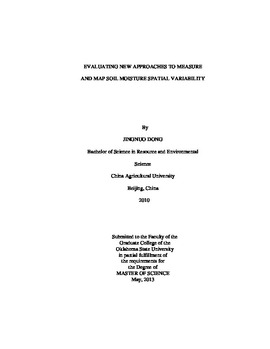| dc.contributor.advisor | Ochsner, Tyson E. | |
| dc.contributor.author | Dong, Jingnuo | |
| dc.date.accessioned | 2014-09-24T14:18:00Z | |
| dc.date.available | 2014-09-24T14:18:00Z | |
| dc.date.issued | 2013-05-01 | |
| dc.identifier.uri | https://hdl.handle.net/11244/11082 | |
| dc.description.abstract | Knowledge of soil moisture spatial patterns provides basic but important information in studies of hydrological processes. At the field to subwatershed scale, soil moisture spatial variability is critical to aid in hydrologic modeling, but has not been adequately studied. Two new approaches were taken to contribute to the study of soil moisture spatial variability at this scale. The Bayesian Maximum Entropy (BME) framework is a more general method than classical geostatistics and has not yet been applied to soil moisture spatial estimation. The recently developed mobile Cosmic-ray Soil Moisture Observing System (COSMOS), i.e. COSMOS rover, has a ~660 m diameter footprint which can potentially be used in field to subwatershed scale soil moisture mapping. The objectives of this research are to compare the effectiveness of BME versus ordinary kriging (OK) for spatial prediction of soil moisture at the field scale, and to calibrate and validate a COSMOS rover for mapping 0-5 cm soil moisture at spatial scales suitable for evaluating satellite-based soil moisture estimates. High resolution aerial photography was incorporated into the soil moisture spatial prediction using the BME method. Soil moisture maps based on the BME and the OK frameworks were cross-validated and compared. The BME method showed only slight improvement in the soil moisture mapping accuracy compared to the OK method. The COSMOS rover was calibrated to field average soil moisture measured with impedance probes which were themselves calibrated to 0-5 cm soil moisture measured by soil sampling. The resulting rover calibration was then applied to map soil moisture around the Marena, Oklahoma In Situ Sensor Testbed (MOISST) in north central Oklahoma, USA and in the Little Washita River watershed in southwest, Oklahoma. The maps showed reasonable soil moisture patterns and a clear response to soil wetting by an intervening rainfall. The rover measured field averaged soil moisture with an RMSD of 0.039 cm^3 cm^-3 relative to the impedance probes which themselves had an RMSE of 0.031 cm^3 cm^-3 relative to soil moisture measured by soil moisture sampling. The results provide evidence that a COSMOS rover can be used effectively for near surface soil moisture mapping with acceptable accuracy. | |
| dc.format | application/pdf | |
| dc.language | en_US | |
| dc.publisher | Oklahoma State University | |
| dc.rights | Copyright is held by the author who has granted the Oklahoma State University Library the non-exclusive right to share this material in its institutional repository. Contact Digital Library Services at lib-dls@okstate.edu or 405-744-9161 for the permission policy on the use, reproduction or distribution of this material. | |
| dc.title | Evaluating New Approaches to Measure and Map Soil Moisture Spatial Variability | |
| dc.type | text | |
| dc.contributor.committeeMember | Carter, Brian | |
| dc.contributor.committeeMember | Zou, Chris | |
| dc.contributor.committeeMember | Cosh, Michael | |
| osu.filename | Dong_okstate_0664M_12687.pdf | |
| osu.accesstype | Open Access | |
| dc.description.department | Plant & Soil Science | |
| dc.type.genre | Thesis | |
